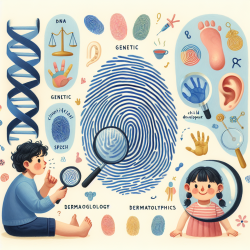Introduction
Fingerprints have long been a subject of fascination, not just for forensic scientists but also for geneticists and developmental biologists. The intricate patterns of loops, whorls, and arches are not merely random; they are influenced by genetic factors. A recent study titled "Genetic variant influence on whorls in fingerprint patterns" provides new insights into the genetic underpinnings of these patterns. This blog aims to explore how these findings can be applied in the field of speech-language pathology, particularly in understanding developmental conditions in children.
The Study at a Glance
The study conducted by Ho et al. (2016) examined the genetic variants associated with fingerprint patterns across different digits. Using samples from the Queensland Institute of Medical Research (QIMR) and the Avon Longitudinal Study of Parents and Children (ALSPAC), the researchers identified significant genetic variants influencing the presence of whorls on fingerprints. Notably, the study found a high heritability for fingerprint patterns, suggesting a strong genetic basis.
Implications for Practitioners
While the study primarily focuses on dermatoglyphics, its implications extend to various fields, including speech-language pathology. Here's how practitioners can leverage these findings:
- Understanding Genetic Influences: The high heritability of fingerprint patterns can serve as a model for understanding genetic influences on other developmental traits, including speech and language development.
- Early Identification: Just as fingerprint patterns can be indicative of genetic predispositions, similar genetic markers could be used to identify children at risk for speech and language disorders early on.
- Interdisciplinary Research: Encouraging interdisciplinary research between geneticists and speech-language pathologists can lead to a more comprehensive understanding of developmental disorders.
Encouraging Further Research
The study opens avenues for further research, particularly in exploring the genetic basis of developmental disorders. Practitioners are encouraged to collaborate with genetic researchers to investigate potential genetic markers for speech and language disorders. Such collaborations could lead to breakthroughs in early diagnosis and intervention strategies.
Conclusion
Understanding the genetic basis of fingerprint patterns is not just an academic exercise; it has practical implications for various fields, including speech-language pathology. By integrating genetic insights into practice, practitioners can improve outcomes for children with developmental disorders. For those interested in delving deeper into the research, the original paper provides a comprehensive overview of the genetic factors influencing fingerprint patterns.
To read the original research paper, please follow this link: Genetic variant influence on whorls in fingerprint patterns.










